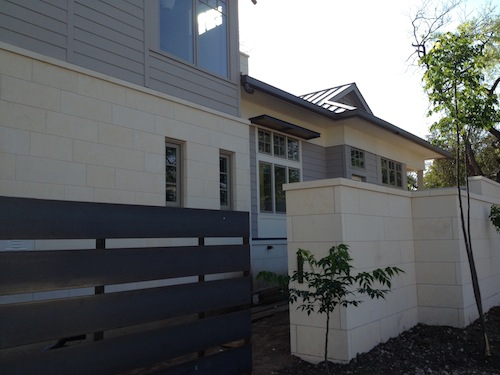
(Image credit: Jay Voss)
There’s an odd thing happening in Austin’s older neighborhoods: people are moving in, tearing down whatever 1930s homes they find on their lots, and in these spaces constructing decidedly modern dwellings. The subsequent structure stands out on its block like you wouldn’t believe. There’s such a disparity between the neighborhood’s older ranch homes and these new structures of corrugated metal and cantilevered edges. It’s a contrast between the standout and the ubiquitous, and the standout wins the eye every time. To make things more interesting: the locals I’ve asked hate these new structures, while those of us who’ve moved here recently tend to find them more inviting. I’m not sure where I stand on the issue. Although I see and understand the detriment one might perceive in continuity’s disruption, isn’t such materialistic continuity exactly what Austinites are constantly going out of their way to subvert? What gives? Aren’t we all supposed to applaud when something immaterial keeps Austin weird? Coming at the issue from a different angle, I’m a fairly serious student of architecture, and so for me it’s always refreshing to see tasteful structures going up (no matter what the situation, really). To this end I think architecture in its purist form encourages balance and harmony, and building a mansion amidst cottages (just for irony’s sake, I guess) is arrogant and misguided.

(Image credit: Jay Voss)
I bring all this up because such a mansion is going in just around the corner from where I live. The site’s been under construction for about 18 months now, which seems a bit long given the speed with which most of the structure’s gone up. Either the project ran into some financing issues or everyone’s really taking their time. I tend to suspect the latter. Crews have constantly been working on the home over the past year – everything from the windows to the floors to the fixtures seems to have been installed with patience and care. This long construction hasn’t bothered me one bit, as I’ve greatly enjoyed considering the uninhabited house. It’s an unconventional structure. For starters, the lot is oddly shaped – it’s an extremely long rectangle (maybe 50 feet by 150 feet). It’s on the edge of a block, with one 150-foot side marked by busy 31st street. The obvious place to put this home would be as far from 31st street as possible, affording the future residents some privacy. Surprisingly, the architect (Jay Farrell) decided to plot the home right along 31st street, with the front of the structure facing inwards towards the side of the neighboring house. The house is at once hidden from and exposed to a busy street, and I can’t decide whether the decision is humble or masturbatory. Before I jump to conclusions, the new residents may have kids or animals that they want to shield from the street, and maybe this is the best way to safeguard the vulnerable.

(Image credit: Jay Voss)
And so it’s interesting to think about how this very modern structure relates to its chosen neighbors. Down the street are a few homes on the Texas State Historical Register, across the street is the Austin Zen Center, across and further along down 31st street are many ranch homes that constitute (I’ve been told) Austin’s old red light district, and to the garage-side of the new home is a small apartment complex that can be a bit rough. Back when the new home’s lot was still vacant, some of the complex’s residents used to blast heavy metal through an open door and try to shoot bottles in the vacant lot with a riffle. In this way, to varying degrees, it has always seemed as though one resident of the complex is imposing themselves on another. I wonder if the proud owners of the new home across the street have any knowledge of this? I wonder if they have any knowledge of the traffic created by the Austin Zen Center on weekends? At heart, I wonder if the attempted urbanism of this lovely new home is compromised by a simple misunderstanding of place.

(Image credit: Jay Voss)
I can’t say what existed in this home’s place previously – it’s been a vacant lot for as long as I can remember – and I’m not sure what my new neighbors are trying to prove. The great architecture is, sadly, a bit like a sore thumb. I’d like to give the architect my approval, however – he designed a great building given what his client’s offered him.




Recent comments
2 years 29 weeks ago
2 years 44 weeks ago
2 years 44 weeks ago
2 years 50 weeks ago
3 years 4 weeks ago
3 years 4 weeks ago
3 years 4 weeks ago
3 years 6 weeks ago
3 years 6 weeks ago
3 years 6 weeks ago